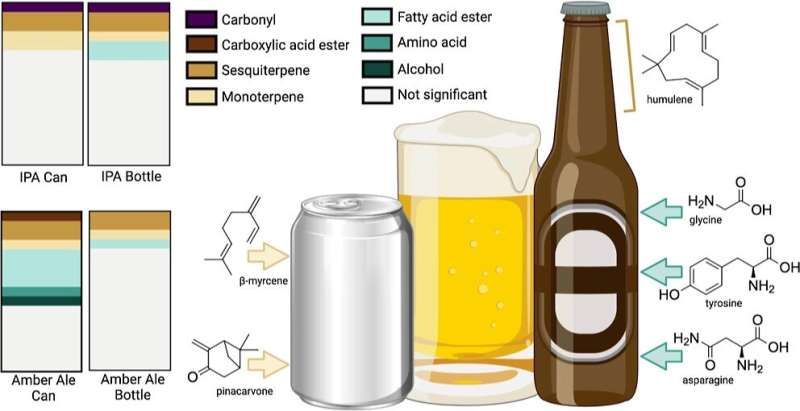This article has been reviewed according to Science X's editorial process and policies. Editors have highlighted the following attributes while ensuring the content's credibility:
fact-checked
trusted source
proofread
Cans or bottles: What's better for a fresh, stable beer?

The flavor of beer begins to change as soon as it's packaged, prompting a debate among afficionados: Does the beverage stay fresher in a bottle or a can? Now, researchers report in ACS Food Science & Technology that the answer is, well, complicated, and depends on the type of beer. An amber ale stayed fresher in bottles, whereas container choice made much less difference to the stability of an India Pale Ale (IPA).
In addition to water and ethanol, beer contains thousands of flavor compounds, which are metabolites produced by yeast, hops and other ingredients. During storage, chemical reactions break down some of those components while forming others. This reduces the content of some tasty flavors while generating unappetizing ones, contributing to the aging, or staling, of beer.
To help brewers prolong shelf life, researchers have studied beer aging, but they've concentrated on light lagers and a limited group of chemicals. Jessica Prenni and colleagues wanted to extend that work to amber ale and IPA, as well as additional compounds. The team also wanted to conduct the first stability comparison of beer packaged in glass bottles versus aluminum cans.
Cans and brown bottles of amber ale and IPA were chilled for a month and then kept at room temperature for five months to mimic typical storage conditions. Every two weeks, the researchers analyzed the metabolites in newly opened containers. Throughout this time, the concentration of certain metabolites in amber ale—including some amino acids and esters—differed significantly depending on whether it was packaged in a bottle or can.
IPA, however, was much less sensitive to packaging type, possibly because of its higher concentration of polyphenols from hops. These compounds not only prevent oxidation but also bind to amino acids, thus retaining them in the beer rather than allowing them to get stuck to the inside of a container.
The researchers also found that the metabolic profile of both amber ale and IPA changed over time, whether packaged in a can or bottle. However, amber ale in cans showed the greatest variation during aging. Once scientists find out how all of these changes affect flavor, brewers will be able to make more-informed decisions about the best type of packaging for their particular type of beer.
More information: Kathryn Fromuth et al, Characterizing the Impact of Package Type on Beer Stability, ACS Food Science & Technology (2023). DOI: 10.1021/acsfoodscitech.2c00351
Provided by American Chemical Society





















